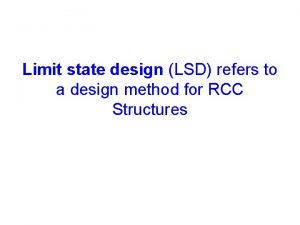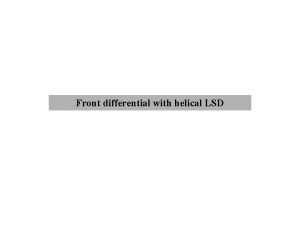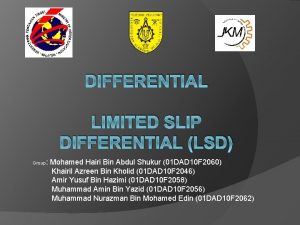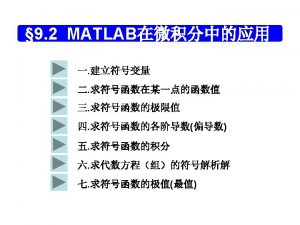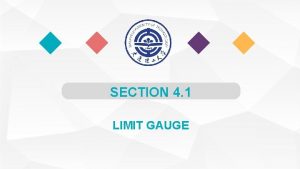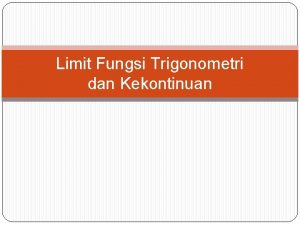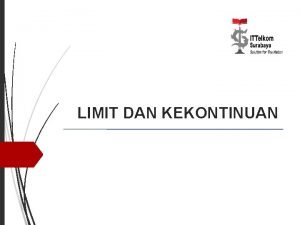Limit state design LSD refers to a design
















- Slides: 16

Limit state design (LSD) refers to a design method for RCC Structures

UNIT-II Topics Covered in this unit are Description of topic No. of Hrs. Introduction to limit state design, concepts Basic statistical pronciples, characteristic loads, characteristic strength, partial load and safety factors 1 2 Stress-strain curves for cold worked deformed bars and mild steel bars 1 Assumptions in limit state design 1 stress block parameters, limitimg MR 2 1

UNIT-II • • LEARNING OBJECTIVES After completion of this unit, student will be able to Understand the design philosophies Understand the concepts of limit state design List the assumptions in limit state design Derive the stress block parameters

• In the working stress or allowable stress method of design, the emphasis is on limiting a particular stress in a component to a fraction of the specified strength of the material of the component. • The magnitude of the factor for a structural action depends upon the degree of safety required. Further, elastic behaviour of the material is assumed. • The main objection to the permissible stress method is that the stress safety factor relating the permissible stress to the strength of the material is not usually the same as the ratio of the strength to the design load. • Thus it does not give the degree of safety based on collapse load.

• In the limit state method, both collapse condition and serviceability condition are considered. In this method, the structure has to be designed to withstand safely all loads and deformations likely to occur on it throughout its life. Designs should ensure that the structure does not become unfit for the use for which it is required. The state at which the unfitness occurs is called a limit state

Limit State: Condition in which a structure or structural element is no longer acceptable for its intended use. Major groups for RC structural limit states Ultimate Serviceability Special

Ultimate limit state – structural collapse of all or part of the structure ( very low probability of occurrence) and loss of life can occur. – Loss of equilibrium of a part or all of a structure as a rigid body (tipping, sliding of structure).

• Limit state design requires the structure to satisfy two principal criteria: • the ultimate state (ULS) and • the serviceability limit state (SLS) • A limit state is a set of performance criteria (e. g. vibration levels, deflection, strength, stability, buckling, twisting, collapse) that must be met when the structure is subject to loads.


Limit state of collapse • • Flexure Shear Compression Torsion

Limit state of serviceability • Deflection • vibration

Serviceability Limit State • To satisfy the serviceability limit state criteria, a structure must remain functional for its intended use subject to routine (read: everyday) loading, and as such the structure must not cause under routine conditions

Special features of limit state design method are: • It is possible to take into account a number of limit states depending upon the particular instance • This method is more general in comparison to the working stress method. In this method, different safety factors can be applied to different limit states, which is more rational than applying one common factor (load factor) as in the plastic design method. • This concept of design is appropriate for the design of structures since any new knowledge of the structural behaviour, loading and materials can be readily incorporated.



 If lclp is negative number, we set the lclp = 0. why?
If lclp is negative number, we set the lclp = 0. why? Limites de control
Limites de control Cara membuat grafik limit fungsi
Cara membuat grafik limit fungsi Working stress and limit state method
Working stress and limit state method Philosophy of limit state design
Philosophy of limit state design Maximum capacity refers to the upper limit of:
Maximum capacity refers to the upper limit of: Maximum capacity refers to the upper limit of
Maximum capacity refers to the upper limit of Sta je lsd
Sta je lsd Lsd methode toepassen
Lsd methode toepassen Lsd construction
Lsd construction Gesprekstechnieken lsd
Gesprekstechnieken lsd Impertinente vraag voorbeeld
Impertinente vraag voorbeeld Cone type limited slip differential
Cone type limited slip differential Luisteren samenvatten doorvragen engels
Luisteren samenvatten doorvragen engels Anabolické steroidy
Anabolické steroidy Synteticke drogy
Synteticke drogy Legalne lsd
Legalne lsd



